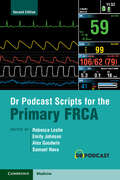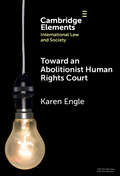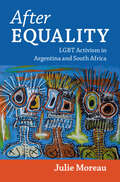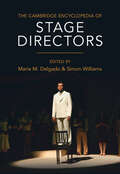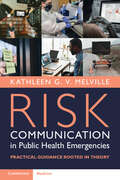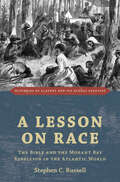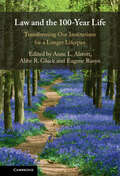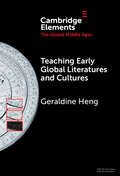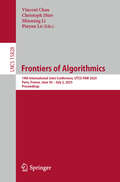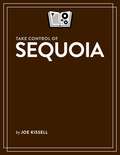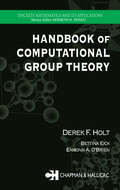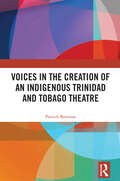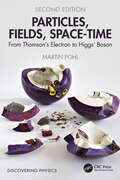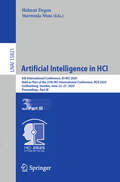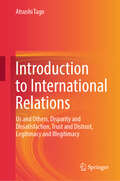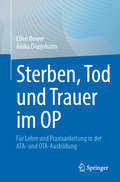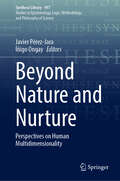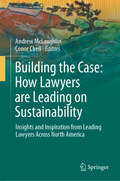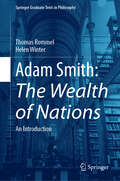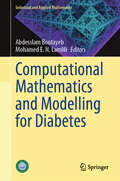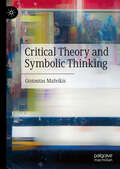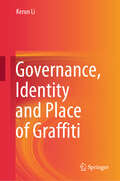- Table View
- List View
Dr Podcast Scripts for the Primary FRCA
by Emily Johnson Rebecca Leslie Alexander Goodwin Samuel NavaWidely popular amongst exam candidates, Dr Podcast Scripts is a great way to revise for your Primary FRCA. Providing questions and model answers spanning the breadth of the exam syllabus and fully updated in this second edition, this revision aid allows you to experience the format of questions likely to be asked and it provides tips on how to excel in the exam. Supplemented with helpful illustrations to explain answers, you will learn what to expect in the exam and how differently worded questions on the same topic require modified approaches. Written and updated by successful candidates providing insight and experience of the exam, all the material has been reviewed by experienced consultants with detailed knowledge of the educational standards. If you are preparing for your Primary FRCA exam, Dr Podcast Scripts for the Primary FRCA is a must!
Toward an Abolitionist Human Rights Court: Rethinking Responses to Gendered and Racialized Violence (Elements in International Law and Society)
by Karen EngleContemporary international human rights law increasingly obligates states to heighten their criminalization of certain human rights violations, including gendered, racialized, and homophobic violence. This Element uses prison and police abolitionist thought to challenge this trend. It focuses on the European Court of Human Rights (ECtHR), arguing that the Court's reliance on punishment and policing threatens to undo earlier European approaches to criminal law and human rights that resonate with abolitionist thought. It also contends that the criminalization approach provides the Court with an alibi for not recognizing or attending to the deeply structural racialized, colonial, sexual, gendered, and homophobic violence in Europe, particularly but not only against Roma communities and Black and Muslim migrants. Encouraging human rights advocates and judges to take seriously prison and police abolition in Europe and elsewhere, the Element calls for the ECtHR to pave the way for an abolitionist-oriented turn among human rights courts.
After Equality: LGBT Activism in Argentina and South Africa (Cambridge Studies in Gender and Politics)
by Julie MoreauAfter Equality tackles one of the biggest challenges facing LGBT activists in many parts of the world: how to move beyond inclusive legislation to ensure LGBT people can exercise their newly acquired rights. Drawing from in-depth interviews and ethnographic observation with two lesbian organizations in Buenos Aires, Argentina and Cape Town, South Africa, Julie Moreau explores the ways that organizations use identity to make rights useful. Engaging interdisciplinary scholarship and intersectional theory, Moreau develops a novel approach to identity strategizing that explains how activists engage multiple identities to challenge the relationships between identity categories and address the ways interlocking systems of power affect their constituents. By analyzing sexual identity as always constructed through race, class and gender, the book transforms how scholars understand the role of identity in the strategic repertoires of social movement organizations and illuminates dimensions of identity politics that surface in the aftermath of legal inclusion.
The Cambridge Encyclopedia of Stage Directors
by Maria M. Delgado Simon WilliamsWith a broader range of entries than any other reference book on stage directors, this Encyclopedia showcases the extraordinary diversity of theatre as a national and international artistic medium. Since the mid nineteenth century, stage directors have been simultaneously acclaimed as prime artists of the theatre and vilified as impediments to effective performance. Their role may be contentious but they continue to exert powerful influence over how contemporary theatre is made and engaged with. Each of the entries - numbering over 1,000 - summarises a stage director's career and comments on the distinctive characteristics of their work, alluding to broader traditions where relevant. With an introduction discussing the evolution of the director's role across the globe and bibliographic references guiding further reading, this volume will be an invaluable reference work for stage directors, actors, designers, choreographers, researchers, and students of theatre seeking to better understand how directors work across different cultural traditions.
August Wilson in Context (Literature in Context)
by Khalid Y. Long Isaiah Matthew WoodenAugust Wilson is one of the twentieth century's most important and acclaimed playwrights. This volume demonstrates Wilson's significance to contemporary theatre, culture, and politics by providing fresh and compelling insights into his life, practices, and contributions as an artist and public intellectual. Across four thematically organized sections, contributors situate Wilson's work in his social, cultural and political contexts, examine ongoing developments in Wilson studies, explore the production contexts of his plays, and explicate his dramaturgical sensibilities and strategies. This is the authoritative guide to Wilson's career and artistic legacy for students, theatre practitioners, and general readers interested in this remarkable figure.
Risk Communication in Public Health Emergencies: Practical Guidance Rooted in Theory
by Kathleen G. MelvilleThis book clearly explains how public health officials plan, deliver, and evaluate crisis and emergency risk communication before, during, and after health emergencies. Organized into four parts - precrisis planning, communicating during a health emergency, communicating and evaluating after a health emergency, and crisis leadership - it offers practical information as well as the opportunity to reflect on emergency risk communication best practices and theories. Including information on precrisis planning, implications of public health law, developing communication plans, writing messages, evaluating emergency risk communication, and crisis leadership, this book brings together theory and practical application to provide working professionals with evidence-based research and practical knowledge to effectively communicate during health emergencies. Case studies of emergencies such as COVID-19, Zika, Ebola, Mpox, and water crises all use the US Centers for Disease Control and Prevention's Crisis and Emergency Risk Communication framework to analyze how health officials provided accurate and actionable health information to the public.
A Lesson on Race: The Bible and the Morant Bay Rebellion in the Atlantic World (Histories of Slavery and its Global Legacies)
by Stephen C. RussellStephen C. Russell tells the story of the Bible's role in Jamaica's 1865 Morant Bay rebellion and the international debates about race relations then occupying the Atlantic world. With the conclusion of the American Civil War and arguments about reconstruction underway, the Morant Bay rebellion seemed to serve as a cautionary tale about race relations. Through an interdisciplinary lens, the book demonstrates how those participating in the rebellion, and those who discussed it afterward, conceptualized events that transpired in a small town in rural Jamaica as a crucial instance that laid bare universal truths about race that could be applied to America. Russell argues that biblical slogans were used to encode competing claims about race relations. Letters, sermons, newspaper editorials, and legal depositions reveal a world in the grips of racial upheaval as everyone turned their attention to Jamaica. Intimately and accessibly told, the story draws readers into the private and public lives of the rebellion's heroes and villains.
Law and the 100-Year Life: Transforming Our Institutions for a Longer Lifespan
by Anne L. Alstott Abbe R. Gluck Eugene RusynLaw and the 100-Year Life addresses the growing trend of Americans living longer and healthier lives, with many reaching the age of 100. An aging nation presents new challenges for society, which must be reimagined to accommodate longer and more varied careers, multiple marriages, and defining moments of education. This volume explores the possibility of a 'third demographic dividend', a new period of productivity following middle age, and the potential for law and policy to support or divide aging citizens. Leading scholars across various fields come together to explore topics related to aging, such as health law and trusts and estates, as well as less obvious but equally important areas like housing, criminal justice, and education. This title is also available as Open Access on Cambridge Core.
Teaching Early Global Literatures and Cultures (Elements in the Global Middle Ages)
by Geraldine HengTeaching Early Global Literatures and Cultures is a guide to the terra incognita of the global literature classroom. It begins with a framing rationale for why it is valuable to teach early global literatures today; critically surveys the issues involved in such teaching; supplies details of some two dozen texts from which to build a possible syllabus; adds a comprehensive bibliography, and suggestions for student research and student involvement in co-creating course content; and furnishes detailed guidelines for how to teach some 10 texts. It should be possible for faculty and graduate instructors to take this Element and begin teaching its sample syllabus right away.
Frontiers of Algorithmics: 19th International Joint Conference, IJTCS-FAW 2025, Paris, France, June 30 – July 2, 2025, Proceedings (Lecture Notes in Computer Science #15828)
by Minming Li Pinyan Lu Christoph Dürr Vincent ChauThis book LNCS15828 constitutes the refereed proceedings of the 19th International Joint Conference on Theoretical Computer Science-Frontier of Algorithmic Wisdom (IJTCS-FAW 2025), consisting of the 19th International Conference on Frontier of Algorithmic Wisdom (FAW) and the 6th International Joint Conference on Theoretical Computer Science (IJTCS), held in Paris, France, during June 30–July 2, 2025. The 28 full papers and 2 short papers were carefully reviewed and selected from 63 submissions. The proceedings focuses on Frontiers of Algorithmic Wisdom; Block-chain, Distributed Computing, Multi-Agents; Game Theory, Algorithmic Game Theory, Machine Learning, Electronic Commerce.
Take Control of Apple Mail
by Joe KissellUse Apple Mail more effectively! Email expert Joe Kissell explains what's new with Mail in Monterey and iOS 15/iPadOS 15, and how to best set up your Gmail, iCloud, IMAP, and Exchange accounts, He then shows you how to take Mail to the next level with plugins and automation, manage your incoming email, customize Mail, and solve common problems.
Take Control of Sequoia
by Joe KissellmacOS 15 Sequoia is one of Apple's most ambitious updates in years. Along with the usual range of new features, it introduces Apple Intelligence, which will permeate many parts of the system and fundamentally change the sorts of things you can do with your Mac and how you do them. This book is your complete guide to what's new in Sequoia—and what Apple has planned for future updates, too.
Take Control of DEVONthink 4
by Joe KissellDEVONthink 4 offers a slew of features for defeating information overload, but mastering its power is easier with real-world advice from DEVONthink power user Joe Kissell. He helps you understand the best ways to put information into DEVONthink and how to organize it so you can find it later. He also covers syncing DEVONthink databases among your Apple devices and using DEVONthink To Go for iPhone and iPad.
Handbook of Computational Group Theory (Discrete Mathematics and Its Applications)
by Derek F. Holt Bettina Eick Eamonn A. O'BrienThe origins of computation group theory (CGT) date back to the late 19th and early 20th centuries. Since then, the field has flourished, particularly during the past 30 to 40 years, and today it remains a lively and active branch of mathematics. The Handbook of Computational Group Theory offers the first complete treatment of all the fundame
Voices in the Creation of an Indigenous Trinidad and Tobago Theatre
by Patrick BrennanThis book explores how, from the mid-20th century, a new form of theatre emerged in Trinidad and Tobago as its playwrights came to mine the Afro-Creole Trinidadian folk milieu. This book focuses primarily on the period from the 1950s through to the contemporary moment, investigating how Trinidad’s theatrical practitioners developed methodologies that formulated an indigenous theatre. It examines how in its creation, it would distance itself from Western forms as the stage was decolonized, making way for a variety of new forms that mimetically reflect the reality of Trinidad’s Afro-Creole folk. This book establishes a premise on which the terms “folk” and “indigenous” have been shaped by Trinidad’s socio-historical past. It develops an argument that outlines how Trinidad’s African cultural retentions form a central basis on which a theatrical tradition was established.This book traces the historical impetus and driving forces that gave rise to a body of writers for whom the vitally important link between the production of drama and the search for identity in the immediacy of the post-colonial period is established. The book develops a structure that forms three lines of discrete research: folk expression, women, their portrayal and their emergence as theatrical practitioners, and theatrical developments through the decades. These subject areas are examined through the work of a broad body of playwrights. Exploring their theory and praxis, their work is described in terms that exhibit a variety of genres, with tropes that have become indelible resources for theatrical practitioners to draw from. With a theatrical base that extends from popular comedy to avant-garde spiritual works, the theatre is shown to represent a composite entity, one that accommodates a plurality of forms, which, in their summation, express the breadth and depth of Trinidad and Tobago’s theatrical journey, one that is still very much underway.Readers that have an interest in theatre, cultural, gender, post-colonial, or Caribbean studies will enjoy this book.
Particles, Fields, Space-Time: From Thomson’s Electron to Higgs’ Boson (Discovering Physics)
by Martin PohlParticles, Fields, Space-Time: From Thomson’s Electron to Higgs’ Boson explores the concepts, ideas, and experimental results that brought us from the discovery of the first elementary particle in the end of the 19th century to the completion of the Standard Model of particle physics in the early 21st century. The book concentrates on disruptive events and unexpected results that fundamentally changed our view of particles and how they move through space-time. It separates the mathematical and technical details from the narrative into focus boxes, so that it remains accessible to non-scientists, yet interesting for those with a scientific background who wish to further their understanding. The text presents and explains experiments and their results wherever appropriate. This book is of interest to a general audience but also to students studying particle physics, physics teachers at all levels, and scientists with a recreational curiosity towards the subject. For this second edition, the complete text has been thoroughly revised. A description of plans for new accelerator facilities has been added, as well as new results on cosmic ray physics, dark matter and dark energy. The usage of natural units has been abandoned in favour of SI units throughout the text.Key Features: Short, comprehensive overview concentrating on major breakthroughs, disruptive ideas, and unexpected results Accessible to all interested in subatomic physics with little prior knowledge required Contains the latest developments in this exciting field
Artificial Intelligence in HCI: 6th International Conference, AI-HCI 2025, Held as Part of the 27th HCI International Conference, HCII 2025, Gothenburg, Sweden, June 22–27, 2025, Proceedings, Part III (Lecture Notes in Computer Science #15821)
by Helmut Degen Stavroula NtoaThe four-volume set LNAI 15819–15822 constitutes the thoroughly refereed proceedings of the 6th International Conference on Artificial Intelligence in HCI, AI-HCI 2025, held as part of the 27th International Conference, HCI International 2025, which took place in Gothenburg, Sweden, June 22-17, 2025. The total of 1430 papers and 355 posters included in the HCII 2025 proceedings was carefully reviewed and selected from 7972 submissions. The papers have been organized in topical sections as follows: Part I: Trust and Explainability in Human-AI Interaction; User Perceptions, Acceptance, and Engagement with AI; UX and Socio-Technical Considerations in AI Part II: Bias Mitigation and Ethics in AI Systems; Human-AI Collaboration and Teaming; Chatbots and AI-Driven Conversational Agents; AI in Language Processing and Communication. Part III: Generative AI in HCI; Human-LLM Interactions and UX Considerations; Everyday AI: Enhancing Culture, Well-Being, and Urban Living. Part IV: AI-Driven Creativity: Applications and Challenges; AI in Industry, Automation, and Robotics; Human-Centered AI and Machine Learning Technologies.
Introduction to International Relations: Us and Others, Disparity and Dissatisfaction, Trust and Distrust, Legitimacy and Illegitimacy
by Atsushi TagoThis textbook provides a comprehensive introduction for individuals who are new to the discipline of International Relations or World Politics. It features three distinctive elements. First, it posits that understanding the international political economy is essential before delving into analyses of war and security, emphasizing that economic interdependence, arising from international cooperation, is a central theme in international relations. Second, the textbook recognizes that strategic interaction — where the decisions of one entity and future outcomes depend on the choices of another — is a core component of international relations. It also utilizes four key concepts in its exploration of the field: Us and Others, Disparity and Dissatisfaction, Trust and Distrust, and Legitimacy and Illegitimacy. Lastly, the textbook is attuned to the methodologies of the Social Sciences, including descriptive, causal, and deductive inferences, and it stands out for its commitment to fostering methodological awareness.
Sterben, Tod und Trauer im OP: Für Lehre und Praxisanleitung in der ATA- und OTA-Ausbildung
by Ellen Rewer Anika DüpjohannDieses Buch richtet sich an Lehrende und Praxisanleitende in der ATA-OTA-Ausbildung sowie Tätige im OP und der Anästhesie. Die Autorinnen schaffen es, ein schwieriges Thema sensibel zu vermitteln und stellen konkrete Konzepte vor, wie das Thema u.a. in der Ausbildung integriert werden kann. So gelingt es, Betroffene individuell und situationsbezogen zu unterstützen, um mit dem Tod eines Patienten im OP oder der Anästhesie umgehen zu können.
Beyond Nature and Nurture: Perspectives on Human Multidimensionality (Synthese Library #497)
by Javier Pérez-Jara Íñigo OngayThis book gathers several of the world&’s leading scholars in the nature vs. nurture debate, offering a timely reconsideration of the dynamic interactions between physical, chemical, biological, social, and cultural factors that shape human multidimensionality. Emphasizing this multidimensionality, this edited volume seeks to bridge the divide between biology and social theory—two research communities that have too often overlooked each other. These disciplines, despite being central to understanding human nature, have long operated in isolation. While some animal species exhibit higher degrees of phenotypic plasticity in specific traits, humans stand out as the most plastic species in both their neurological and sociocultural systems. This plasticity leads the contributors of this book to move beyond both biological reductionism and the blank-slate hypothesis. While biology undoubtedly plays a role in shaping and stabilizing human social and cultural processes, it does so only within the framework of an inherently social environment—one shaped by historically contingent and socially constructed realities, such as values, codes, and cultural perceptions. More importantly, cultural structures and social interactions actively shape and transform certain biological features that were once considered immutable. This book lays the groundwork for a productive dialogue among biologists, psychologists, social theorists, and philosophers. It also highlights some of the moral and political consequences of different perspectives within the nature vs. nurture debate. Through updated scientific and philosophical theorizing, the chapters in this book aim to overcome, once and for all, the simplistic yet persistent opposition between nature and nurture, offering a far more complex and dynamic—yet richer and epistemologically manageable—picture of the human being.
Building the Case: Insights and Inspiration from Leading Lawyers Across North America
by Andrew McLaughlin Conor ChellThis book aims to inspire a new generation of lawyers by showcasing real-life case studies of how legal professionals have built successful and rewarding careers in the field of sustainability. In the corporate world, over the last decade environmental, social and governance (ESG) and sustainability considerations have moved from the fringe to the mainstream - a shift that has faced significant backlash in certain quarters. At the same time, the global backdrop has become increasingly complex, marked by the accelerating impacts of climate change (e.g. historic floods and wildfires), political polarization, economic uncertainty, wars, and the further erosion of trust in our institutions. In this new era, corporate leadership is increasingly turning to lawyers, both in-house and external counsel, to help lead the way in navigating these complexities and to pursue opportunities through the green energy transition. This book brings together a diverse group of leading lawyers who have spearheaded innovative initiatives to drive positive environmental and social change. These thought leaders share their firsthand experiences, challenges, and triumphs, providing inspiration for aspiring lawyers eager to make a meaningful impact in their careers.
Adam Smith: An Introduction (Springer Graduate Texts in Philosophy)
by Helen Winter Thomas RommelThis textbook provides an accessible introduction to Adam Smith, one of the most important economic thinkers. His seminal work The Wealth of Nations is a classic text in philosophy, social sciences and economics. This introduction puts Smith&’s central ideas on the division of labour, the invisible hand and the market into context. A careful analysis of key passages from Smith&’s writings explains how he arrived at a theory of society and the market that has become central to our understanding of human motives. The discussion of Smith&’s The Wealth of Nations is followed by sources from the 18th century that shaped Smith&’s analysis of human motives and propensities. This introduction is indispensable reading for an informed discussion of the mechanisms that govern human society. It provides an introduction to Adam Smith as one of the most astute thinkers of the 18th century, whose ideas shape modern concepts of the market, making it ideal as course material in courses such as economics, history, political sciences, sociology, literary studies, philosophy.
Computational Mathematics and Modelling for Diabetes (Industrial and Applied Mathematics)
by Abdesslam Boutayeb Mohamed E. N. LamliliThis book is a theoretical and pragmatic tool that applies mathematical modelling in understanding and managing diabetes and related complications such as diabetes predisposition, diabetes onset, regular glycaemic monitoring, glycated haemoglobin HbA1c, diabetes homeostasis, gestational diabetes and other associated diseases and conditions. Chapters in the book provide mathematical models dealing with the dynamics of insulin/glucose, the evolution from pre-diabetes to diabetes without and with complications, gestational diabetes and the association between diabetes and benign prostatic hyperplasia. It also applies new methods such as data mining, machine learning and deep learning. By offering pragmatic examples and comprehensive reviews on mathematical models used for diabetes, this book is useful for advanced researchers, academic teachers, students, scientists and high pharmaceutical industry executives willing to start modelling.
Critical Theory and Symbolic Thinking
by Gintautas MažeikisThis book interprets axial cultural symbols, specific cultural symbolic organizations, and symbolic constellations in the context of Critical Theory and its negative dialectic. It engages the origins, structures, weaknesses, and possibilities of symbolic thinking, and incorporates ideas from a range of thinkers, including Hegel, Nietzsche, Marx, Adorno, Horkheimer, and Benjamin, among others. The book charts a new way of looking at the role of philosophy in culture, and provides tools for a new insight in the history of the formation of the consciousness of symbolic thought within philosophy itself. Furthermore, it shows how practically useful symbolic thinking can become in the practices of philosophical diplomacy, the processes of communication, mutual understanding and the formation of contemporary political and cultural discourse.
Governance, Identity and Place of Graffiti
by Kerun LiThis book offers a comprehensive overview of graffiti culture in China, particularly through the example of graffiti in the Furong Tunnel at Xiamen University. It explores the complex relationship between graffiti as an art form and social behavior, focusing on its definition, legality, public space conflicts, sense of place, and interactions under management systems. Firstly, the book discusses the varying definitions of graffiti in Western and Chinese contexts. Using the Furong Tunnel graffiti as a case study, it examines the line between artistic expression and vandalism, highlighting issues of legality, sense of place, and publicness. Secondly, it delves into the practice of graffiti in public spaces, particularly within Xiamen University. The graffiti in the Furong Tunnel has sparked debates about the conflict between educational and social functions, altering the tunnel's spatial form and function. It has become a focal point for conflicts between tourists and students, reflecting the complexity of campus space. The book also explores how graffiti constructs a sense of place and its associated social conflicts. By tracing the historical development of tunnel graffiti, it shows how graffiti becomes a collective memory and cultural symbol, serving as a medium for students to express emotions and construct local identities. Furthermore, the book addresses the legality of graffiti and the negotiation among actors under management systems. Although not legally considered a tourism resource, the university's stance is ambiguous, balancing strict regulations with using graffiti for publicity. Specific incidents of vandalism highlight conflicts between graffiti culture and campus management, discussing issues of protection and restoration. Lastly, the book examines ownership and management of graffiti. Conflicts over preservation and usage rights between students and tourists show the university's role as a coordinator. It emphasizes graffiti's importance in campus culture and as a promotional tool, while also noting that management measures might limit free expression, leading to homogenization concerns. Using multiple research methods, this book explores the social and political implications of graffiti, emphasizing the interactions and conflicts among stakeholders. It reveals the significance of graffiti in Chinese society and offers solutions to issues concerning graffiti culture in contemporary China.
